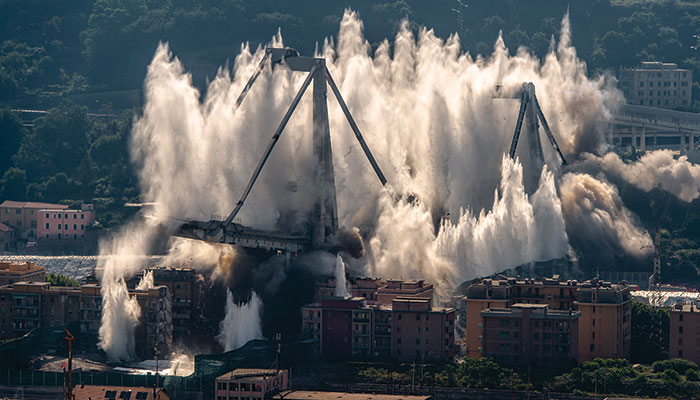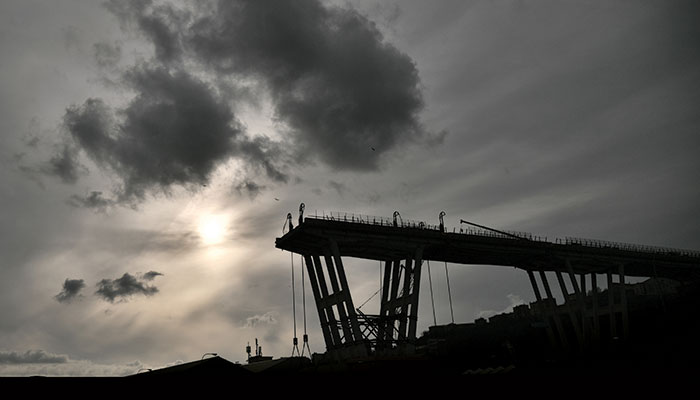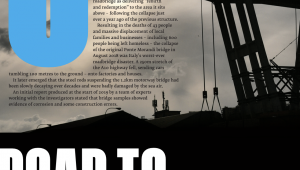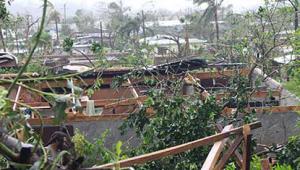Upon the banks of the Polcevera River in Genoa, Italy, a structure is taking shape that will eventually form a state-of-the-art roadbridge – designed for free by world-famous Italian architect Renzo Piano, creator of London’s Shard and The New York Times headquarters, and “built to last 1,000 years”.
Piano has described the emerging roadbridge as delivering “rebirth and redemption” to the area it sits above – following the collapse just over a year ago of the previous structure.
Resulting in the deaths of 43 people and massive displacement of local families and businesses – including 600 people being left homeless – the collapse of the original Ponte Morandi bridge in August 2018 was Italy’s worst-ever roadbridge disaster. A 250m stretch of the A10 highway fell, sending cars tumbling 100 metres to the ground – onto factories and houses.
It later emerged that the steel rods suspending the 1.2km motorway bridge had been slowly decaying over decades and were badly damaged by the sea air.
An initial report produced at the start of 2019 by a team of experts working with the investigators stated that bridge samples showed evidence of corrosion and some construction errors.
Other experts have since claimed the support cables for the bridge were “difficult to inspect” and, in years gone by, it had become unclear how they were coping with increased traffic loads.
Prosecutor Francesco Cozzi, opening a criminal investigation for multiple manslaughter, revealed that some parts of the bridge had not been examined for 25 years.
Moreover, having been constructed to handle 5 million cars a year, the bridge was handling five times that amount by the time of its collapse.
“It was not just misfortune,” said Cozzi at the launch of the investigation, which is due to be concluded in December 2019. “We need to understand if the structure of the bridge was able be kept in operation, in the state in which it was at that time. We need to verify if this bridge was able to support 25 million vehicles a year without limitations. [Original engineer] Riccardo Morandi built it for 5 million vehicles a year.”
The upkeep of the bridge was managed by Italian infrastructure company Atlantia and, according to an investigation by the Financial Times in the wake of the tragedy, Atlantia’s board had warned Italian transport ministry officials of safety concerns and construction weaknesses six months prior to the collapse.
The FT reported that the revelation had “undermined efforts by the populist coalition’s attempts to pin blame for the disaster squarely on Autostrade and its parent company Atlantia” – and called into question Italy’s handling of other infrastructure projects.
Certainly, many Italian infrastructure projects have experienced funding issues. In July this year, the Italian government’s Interministerial Committee for Economic Planning, CIPE, confirmed funding for improvements to the country’s national rail network.
However, work on construction of the Brescia–Padova section of the country’s high-speed corridor had already been authorised, after a cost-benefit review had found that it would be more beneficial to complete the project than paying cancellation penalties to a consortium that had been selected as contractor for the scheme as long ago as 1991.
Another Genoa project, a proposed 72km subterranean highway called ‘Gronda’, designed to help reduce traffic on the Morandi bridge, remains in the planning stage – despite the initial proposals dating back to 1984.
web_p28_gettyimages-1152494570.jpg

The remaining parts of the bridge were demolished to make way for the new structure
Italy’s economy has spent much of the century in a sickly state, suffering from sluggish growth. That slow growth has left its economic output still 5% below its pre-crisis peak of 2008.
But how have such budgetary pressures affected infrastructure spend?
The World Economic Forum assesses the quality of infrastructure as part of its Global Competitiveness rankings, plotting the most recently available figures – from The Global Competitiveness Report 2017-18 – against average government expenditures (% GDP) for the past 20 years.
Italy, with the seventh highest government spending, ranks only 27th in the WEF’s index for infrastructure, and has the fourth worst transport infrastructure among advanced economies
Japan (ranked fourth), Switzerland (sixth) and the US (ninth) have superior infrastructure while spending respectively 11%, 16% and 13% of GDP less than Italy.
Hong Kong and Singapore take first and second place in infrastructure quality, while spending much less than half of what Italy spends - a difference equating to 30% of GDP. Germany, Spain and the Netherlands have better infrastructure while also supporting a generous, European-style welfare state –with lower government spending.
The conclusion? That Italy’s governments could provide much better infrastructure without additional spending.
Today, tales from on the ground reveal that many projects are at a standstill or ‘blocked’.
According to a report by the Italian association of private construction contractors, ANCE, 749 projects are currently blocked and €62bn is at risk of being wasted through “a vicious cycle combining high levels of bureaucracy, financial difficulties and political decision-making”. ANCE president Gabriele Buia says research by the Presidency of the Council of Ministers shows that, based on current approaches, it would take Italy an average of 16 years to complete a €100m infrastructure project, but that more than half of this time – 55% – would be taken up by bureaucracy.
Despite this, Buia says a focus on improving the country’s crumbling infrastructure could provide a much-needed boost to its economy.
“Italy is not growing and we are very worried,” he says. “At present, we need a minimum of two years to complete a maintenance project valued at just €200,000-€300,000.
“Infrastructures tend to be checked only upon request or after a report. Instead, we should be arranging planned maintenance projects to secure our infrastructures at set times. We have never had that. It should be included in each project and would boost the economy.”
'Infrastructures tend to be checked only upon request or after a report. Instead, we should be arranging planned maintenance projects to secure our infrastructures at set times. We have never had that.'
Gabriele Buia, president, ANCE association of private construction contractors
Speeding up the progress of infrastructure projects will offer more jobs too, he adds. “The new cabinet’s priorities should include speeding up projects and reducing bureaucracy. In Italy, for each billion spent on infrastructure, we generate 15,000 jobs.”
However, Michele Corradino, a judge at the Italian Anti-Corruption Authority, ANAC, says that, in recent years, projects have begun to gather greater momentum, and that a downturn seen around 2016 was the result of regulatory pressures.
“I don’t agree that public contracts were blocked [by government],” he says. “In 2016, the number of public contracts collapsed, registering a 17.8% downturn in construction works and a 17.5% downturn in services from 2015 figures.
“The reason was that a new code of contracts came into force. It changed completely the working method. The administrations did not know how to apply to this new legislation, which depended on EU directives. The sector was locked as a result. But, in the following two years, contracts have started again, reaching a historic peak of €139.5bn in 2018 – up 38.7% on 2016. In Italy, now, there are tools to manage contracts efficiently and legally.”
“The bureaucracy is still too high in Italy,” Buia counters. “An ‘unblock construction sites’ law was recently approved to help improve the situation. However, there is still uncertainty.”
While Buia and Corradino clearly differ on the pace of Italy’s infrastructure projects, they do however agree that some smaller initiatives are now having an impact on local communities.
Following the example of Plan España, launched by the Spanish government 10 years ago, the Italian government recently allocated funds specifically for maintenance projects relating to municipal roads and schools in small Italian towns. Last year, €400m of funding went to villages with under 20,000 residents. More than 7,000 small towns benefited from improved infrastructure, and, within five months, 96% of the public contracts were completed.
In addition to such initiatives, a nation that is working hard to remove an image of corruption is laying down the foundations for a more sustainable future.
Initiatives such as the AINOP online database – a Ministry of Transport and Infrastructure site that monitors the conditions of bridges, streets, railways, metro lines, airports and ports – are addressing safety concerns. Each building has a specific code, and the site logs data on its history and improvements made.
Moreover, in September last year, the Italian government sanctioned the launch of a new agency, ANSFISA, to take on the task of “supervising and directly verifying” the maintenance procedures of road and motorway operators and carrying out inspections and sample checks on infrastructure, “forcing managers to implement the necessary risk control measures”.
Whoever is responsible for Italy’s past neglect of infrastructure projects and maintenance, moves are afoot, it seems, to professionalise the nation’s infrastructure. How quickly improvements will be made - and the impact of those on the local economy - remains to be seen.
Disaster waiting to happen
Genoa’s pre-stressed concrete Ponte Morandi bridge – formally known as Viadotto Polcevera – was built between 1963 and 1967 by engineer Riccardo Morandi. The structure was 1,182m long, 18m wide and 90m high, and cost almost 4bn Italian lire. The bridge was seen as a symbol of Italy’s economic revamp and nicknamed ‘Brooklyn Bridge’, even though it was constructed from concrete rather than steel.
The Ponte Morandi was a cable-stayed bridge, characterised by a pre-stressed concrete structure for the piers, pylons and deck, very few stays – as few as two per span – and a hybrid system for the stays, constructed from steel cables with pre-stressed concrete shells poured on.
The bridge had been subject to continual restoration work in the 1970s, owing to an incorrect initial assessment of the effects of concrete creep. In a 1979 report, Morandi himself recommended: “Remove all traces of rust on the reinforcements, fill the patches with epoxy resin, and cover everything up with elastomer of very high chemical resistance.”
A subsequent study of the bridge’s stays took place in 2017. On pillar nine, only four global modes could be identified, and only two were fully compliant with standards. A year later, during torrential rain storms, a section of the bridge collapsed, causing the deaths of 43 people.
The remaining parts of the bridge were demolished earlier this year, making way for a new structure carrying 43 street lights – one for each victim of the disaster.
The new structure is due to be completed in 2020.
 Italy signs up to ‘silk road’
Italy signs up to ‘silk road’
Earlier this year, Italy became the first G7 country to sign up to Beijing’s controversial Belt and Road Initiative, as well as a range of other trade and infrastructure agreements.
The BRI, signed by Italian prime minister Giuseppe Conte during a visit by Chinese president Xi Jinping (both pictured right), has been described by analysts as one of the largest and most ambitious foreign policy and economic plans in modern history, as it aims to re-establish a ‘silk road’ connecting China’s underdeveloped regions to Europe via Asia.
Conte became the first G7 leader to back and sign a memorandum of understanding endorsing China’s landmark multi-billion-dollar BRI plans.
The Italy-China MOU also covered satellites, cooperation in banking, agriculture, natural gas, steel and an increase in bilateral trade.
27th place
Italy’s position in the WEF index for infrastructure, even though it ranks seventh highest for government spending. It also has the fourth worst transport infrastructure among advanced economies.














